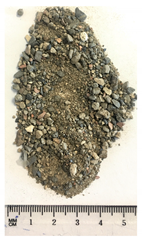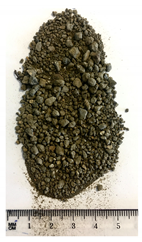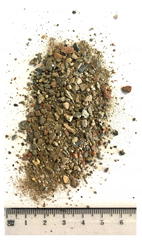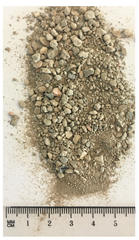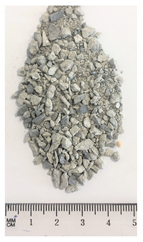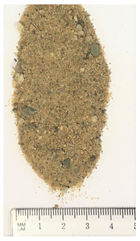Abstract
Fine recycled aggregates (FRA) (0/4 mm) are up to now not valorized on a high enough level because of characteristics like an elevated water absorption, higher fines content, and the presence of contaminations. Leftover gypsum residues from the construction site can cause internal sulfate attack when FRA are incorporated into new structures. Concern about this deteriorating reaction plays an important role in the rejection of FRA. In this study, samples of FRA from different recycling centers were characterized and incorporated into mortars. They were then subjected to swelling tests in order to evaluate the development of sulfate attack. Reference materials with different amounts of sulfates were used as a comparison. Results showed a variable sulfate content in industrial FRA, depending heavily on the source of the materials. In all but one case, the total amounts surpassed the acceptable sulfate contents specified in the European standard EN 206, meaning the FRA would be rejected for reuse in concrete. Nevertheless, swelling tests demonstrated that these contamination levels did not pose a risk for sulfate attack. These results indicated that the incorporation of FRA leads to acceptable mechanical performances and that the sulfate limit could be reviewed to be less strict.
1. Introduction
The building sector is infamously known as the 40%-industry, using 40% of global energy and resources, and is responsible for one-third of our greenhouse gas emissions [1]. Nowadays, 1 m3 of concrete, corresponding to more or less 2 tonnes, is being produced per person per year. The climate impact of the construction industry can be reduced by 77% by core material separation and its recycling or reuse [2]. Accounting for approximately 25–30% of all waste generated, Construction and Demolition Waste (C&DW) is one of the heaviest and most voluminous waste streams in the EU and as such has been identified as a priority waste stream by the European Union [3]. C&DW consists of numerous materials, including concrete, bricks, gypsum, wood, glass, metals, plastic, and excavated soil [4]. The major fraction of C&DW however is mineral waste, which has a high potential for recycling and reuse [5]. One of the objectives posed in the Waste Framework Directive (WFD) of the European Union (2008/98/EC) is to reuse a minimum of 70% of C&DW by 2020 [6], either by backfilling as road bases or—the most preferrable high-quality application—reusing them in the form of Recycled Aggregates (RA). RA are reprocessed from C&DW and can be used in mortar or concrete as a replacement for natural aggregates (NA) [7,8]. This practice reduces the amount of debris disposed of in landfills, reduces the rate of natural resource depletion, and provides energy, cost and transport savings [9]; 1.7 tonnes of these recycled aggregates are produced per person per year in Europe, waiting to be valorized [10].
The use of coarse recycled aggregates has been shown to produce concrete with acceptable properties [11,12,13,14,15]. Fine recycled aggregates (FRA), however, have more nefarious characteristics and their incorporation into a new concrete is up to now generally avoided [16,17]. These properties include—among others—a higher water absorption [18,19]; a lower density; and the presence of contaminations from the construction or demolition site such as plaster, bricks, wood, etc. [20,21]. Existing studies often focus on mechanical properties, and research is needed on the durability aspects of the incorporation of FRA.
Gypsum (CaSO4·2H2O) is used in the construction sector firstly as an addition to Portland cement, to regulate the setting time of cement and prevent a flash set [22]. Besides that, gypsum is the major constituent of plaster walls in buildings. Demolished concrete particles contain adherent cement and plaster, which will lead to a certain sulfate content in recycled aggregates after the crushing process. The effective sulfate concentration in RA will of course depend on the type of the source concrete but most stocks of RA in recycling centers are mixed from different sources and demolition sites: a sulfate contamination is a very realistic concern for RA. Larger concrete and gypsum particles can be separated from each other based on a difference in color [23] or density [24], but these techniques are not applicable on the smallest size fractions. Especially in FRA, gypsum is an important contaminant to be considered: the water-soluble sulfates coming from the gypsum particles strongly limit their valorization potential [25].
Sulfate attack is a deteriorating process where sulfates dissolve in water and react with aluminate hydrates in a hardened cement paste to form secondary ettringite. It is assumed that this mineral exerts a pressure on its surrounding cement paste and thereby causes a volumetric deformation [26]. Macroscopically, the concrete structure will show swelling behavior and the formation of (micro)cracks. Primary ettringite is a normal hydration product in the cement paste: it is only secondary ettringite, formed in an already rigid cement matrix, that risks causing a swelling reaction.
A distinction can be made between different types of sulfate attack. External sulfate attack happens when the sulfates diffuse into the concrete from an aggressive environment [27]. Another reaction called Delayed Ettringite Formation (DEF) occurs when primary ettringite is destroyed by high curing temperatures and formed anew in a hardened cement paste. The sulfates in this case come from cement, an internal source [22,26,28] .
While external sulfate attack and Delayed Ettringite Formation are well researched and understood, the reaction caused by the presence of gypsum in FRA is not. The gypsum residues contaminating FRA are another internal source of sulfates and unlike with the DEF reaction, high curing temperatures are not needed to observe the swelling effect of ettringite formation. The term “secondary ettringite formation” will be used to distinguish this reaction from DEF.
To keep the risk for secondary ettringite formation at a reasonable level, the current water soluble sulfate limit in coarse recycled aggregates is established at 0.2% by EN 206 [29], with no specific mention of FRA. The conclusions of recent durability studies indicate a higher level should be made possible [30], specifically up to contents of 0.3% [31].
In this study, different sources of FRA were characterized for their sulfate content, water absorption, and size distribution; this provided information about the variability in characteristics between industrially available FRA. The materials were then incorporated into mortars. Swelling tests performed on these mortars indicated whether or not the found contamination levels did indeed cause a deterioration. Ultimately, these results might provide a better understanding of the long term effects of sulfate attack in the context of construction and demolition waste and will promote the use of these recycled materials in the building sector.
2. Materials and Methods
Six samples of recycled aggregates were collected from recycling centres in Belgium, of which only the 0/4 mm fraction was characterized and used. They are named “A” to “F”. In total, 3 recycling plants were sampled: of the six FRA samples, four were from different batches of the same recycling plant. As a reference sample, a pure FRA was also made in the laboratory by fabricating and crushing a standard concrete. This sample is called “REF”. The composition of this original concrete was designed to obtain a consistency class S3 and strength class C30/37, and was made with CEM I and limestone aggregates. After 90 days of curing, this concrete was crushed by a jaw crusher and the resulting 0/4 mm fraction was used as FRA. The use of this “model” FRA as a reference gave exact control of the chemical composition of the materials and removed any possible variability or contamination at the level of the aggregates by chlorides, organics, etc. The results on FRA are compared with those from a natural limestone aggregate called ’NS’.
2.1. Characterization
All FRA samples were characterized for their size distribution according to EN 933-1 [32].
Only water-soluble sulfates contribute to secondary ettringite formation. The procedure described in EN 1744-1 [33] for the determination of water-soluble sulfates in recycled aggregates was followed with two adaptations to the testing protocol. First, an elevated temperature to extract the sulfates was not used because gypsum exhibits a retrograde solubility [34]. Second, sulfate concentrations were measured with ion chromatography instead of spectrophotometry, which is an easier, safer, and more precise analytical technique [35].
Water absorption and particle density of the FRA were determined via the method described by Zhao et al. [18]. Characterization techniques for natural aggregates, described in EN 1097-6 [36], consistently underestimate the water absorption of FRA because of the fineness and agglomeration issues between the particles. The method, designed in response to this difficulty, by IFSTTAR [37] seems to overestimate the water absorption of FRA, but works well for particles in the 0.5/4 mm range. Thanks to an excellent correlation between the hardened cement paste content or mass loss at 475 C and the water absorption, the water absorption of the fines can then be extrapolated. Using the water absorption of each size fraction (either measured for the coarser particles or calculated for the fines) is more accurate than using either of the two mentioned experimental methods for the whole 0/4 mm bulk [38].
2.2. Swelling Tests
The industrial FRA were used in the manufacture of mortars, to monitor their swelling over the course of 6 months. Three extra mixes were prepared to serve as reference samples:
- Two mixes that will compare the industrial FRA with either a natural aggregate (named “NS”) and a pure crushed concrete (the reference FRA named “REF”). Both the natural and the recycled aggregate are manually contaminated with 0.5 mass% of gypsum. This 0.5% of gypsum corresponds to to 0.29% of sulfates, which reflects the sulfate contents found in industrial FRA. In the case of FRA, this manual contamination is in addition to the water soluble sulfates already found during the characterization, bringing its total sulfate content to 0.47%.
- One mix made with the reference FRA and a very high gypsum content of 5 mass%— corresponding to 2.9% of sulfates—to exaggerate the consequences of sulfate attack. Again, this manual contamination is in addition to the sulfates already present in this FRA, bringing the total sulfate content to 3.08%.
The gypsum used to contaminate the aggregates was a CaSO4·2H2O powder (D50 13 m) obtained from VWR Chemicals.
In order to compare only the influence of the different sulfate contents of the sands, other variations between the different aggregate types were reduced as much as possible:
- To account for their difference in size distribution, all aggregates were recomposed to match the size distribution of the reference FRA. This adaptation caused a slight change in the total sulfate content, water absorption, and density. These new values were recalculated.
- To account for their difference in density, a volumetric equivalent of every aggregate was added to the mortars instead of a mass equivalent, to keep the aggregate envelope volume constant.
- To account for their difference in water absorption, all aggregates were pre-saturated one week before mixing, with their absorbed water and 10% of the mixing water. This assures the same amount of effective water in all mixes, proven to be an important factor in the swelling process [39].
The standard procedure described in EN 196-1 [40] for mortar fabrication was followed. A CEM 52.5 N from HOLCIM in Belgium was used for all mortars.
To follow the development of the internal sulfate attack reaction, the mortar specimens were subjected to different tests. The mass, length [41], and resonance frequency were recorded weekly to observe features of sulfate attack such as swelling and possible internal cracking. Length measurements were performed with a digital length comparator, which gives the length of a mortar bar accurately up to 0.001 mm, relative to an Invar reference rod. At 7, 28, 90, and 180 days the mortars were characterized mechanically for their flexural and compressive strength [40]. One sample that showed significant swelling was analyzed with XRD using a Bruker D8 Advance diffractometer according to the powder diffraction method with a Co K1 radiation, sweep from 10 to 200 2. Every described test was done for 3 replicate mortars.
3. Results and Discussion
3.1. Characterization
Of the six collected FRA samples, four were from different batches of the same recycling plant. Because of their small particle sizes, it was not possible to obtain a detailed composition of these materials. The industrial sources named these samples “mixed aggregates”, indicating that next to concrete also bricks and other construction materials can be present. Their original characteristics are shown in Table 1. To obtain FRA samples ready for characterization and subsequent incorporation into mortars, they were dried at 40 C and sieved to keep the 0/4 mm fraction. From the pictures in Table 1, a large variability between the different sources can be seen, and contaminations with soil, brick, wood, plastic, or gypsum particles. Their impurity becomes especially clear when compared to the pure crushed concrete “REF”.

Table 1.
The different samples of aggregates and their original size distribution. Pictures shown are after drying at 40 C and separating of the 0/4 mm fraction. The “model” FRA and natural aggegrate that were used for reference mortars are also presented.
The particle size distribution of the FRA samples is shown in Figure 1. A very high variability in characteristics was found between the different industrial sources.
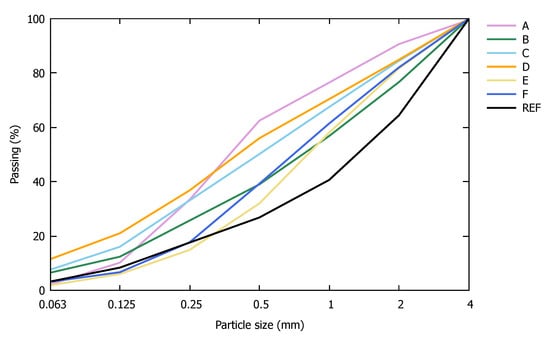
Figure 1.
Particle size distribution of the used fine recycled aggregates (FRA).
In Figure 2, the water-soluble sulfate content of the FRA is shown for the total 0/4 mm sample as well as per size fraction. All but one source of FRA surpassed the maximum allowable sulfate limit of 0.2% specified by EN 206 [29], indicating they would be rejected for use in a new concrete. The reference FRA, which was a pure uncontaminated crushed concrete, also contained 0.18% of sulfates, which originated from the leaching of cement particles.
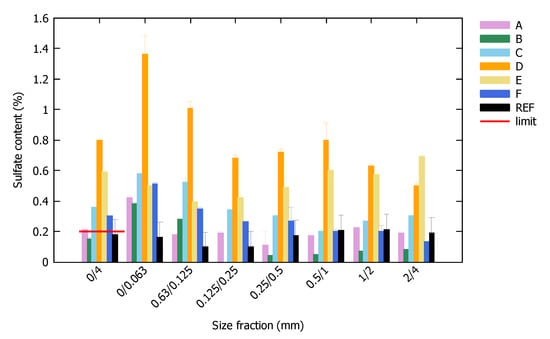
Figure 2.
Water soluble sulfate content of the FRA in total and per size fraction.
Sulfates are predominantly present in the smaller size fractions, except for sample E and REF. This is explained by the brittleness of gypsum during the handling process of construction and demolition waste, and by the increasing presence of cement particles in the finer size fractions [42,43,44]. The sulfates accumulating to the finer fractions partially explains why—contrary to coarse recycled aggregates—FRA are not valorized.
Table 2 summarizes other characterization results. Again, a large difference in characteristics was noticed, proving the necessity of a thorough characterization of FRA before incorporating them into a mix. An elevated water absorption is one of the key aspects of recycled aggregates, and these ranged from 6.1% to 14.6% over the different samples. No apparent correlation was found between this water absorption and the sulfate content (Figure 2) or the amount of fine particles (Figure 1).

Table 2.
Characterization of the used FRA before recomposition and effective values in the mortars after recomposition.
3.2. Swelling Tests
Recomposing all aggregates to obtain a uniform size distribution slightly changed their total water absorption, density, and sulfate content. The recalculated values of these recomposed aggregates are shown in Table 2. Taking these values into account, the composition of the mortars was calculated and shown in Table 3. An amount of added gypsum was then recalculated into the corresponding amount of sulfates, giving the total water soluble sulfate content for each mortar in the sample name. These mixes were made in triplicate.

Table 3.
Compositions, in g, of the mortars, using the values of the recomposed FRA from Table 2. The samples are named after the source of their FRA, and the water soluble sulfate content in their mix expressed as a mass % of the aggregate fraction.
The 6-month swelling behavior of these mortars is shown in Figure 3. Except for “F-0.18%” which showed a lower expansion, no statistical differences (p < 0.05) were found between the length changes of the industrial FRA sources and the 2 reference mortars with similar sulfate contents. More information about statistical differences between the results can be found in Table S1 and Figure S1 in the Supplementary Information. There was also no correlation between the absolute swelling amount and the sulfate content of these mortar mixes. It was, however, very clear that sulfates do indeed cause a swelling reaction—as can be seen from the curve of REF-3.08%, but an exaggerated contamination level was needed for this result. The sulfates present in the industrial FRA were not enough to provoke a significant swelling reaction even though they largely surpassed the 0.2% limit. The length change curve of sample REF-3.08% stabilized after one month, which is a much faster reaction than seen in literature for other types of sulfate deteriorations like DEF or external sulfate attack, that often go on over multiple years [28,45,46,47].
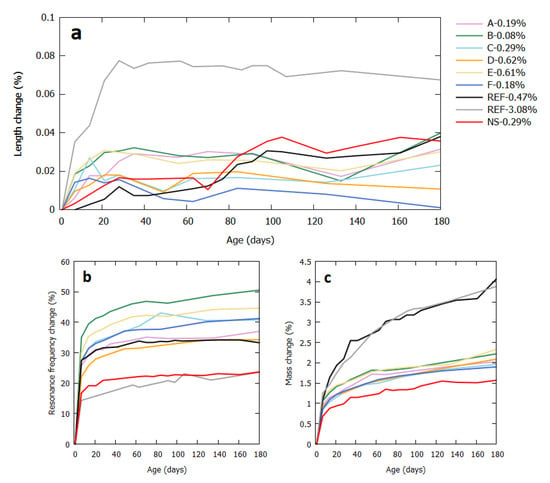
Figure 3.
Six-month swelling behavior of the mortar samples, including their length change (a), resonance frequency change (b), and mass change (c).
The resonance frequency test is a measure for the internal damage in the mortar sample. If microcracks were formed, they would manifest as irregularities in their frequency curves, but this was not the case for these mortars. Even though significant swelling was attained for REF-3.08%, it was nevertheless not severe enough to cause internal fissuration.
The mass of the mortars kept steadily increasing each week, because of ingress of the water in which they were kept. The mortars made with the reference FRA gained more mass, because of their irregular shape which captures more air into the mixture than a round aggregate [30,48]. For the reference FRA specifically, a high air content in mixes with this material was already observed [49]. Industrially fabricated FRA are rounder by nature than laboratory crushed FRA [50], explaining why their results lie between those of the natural aggregates and the reference FRA.
An XRD analysis on “REF-3.08%” (Figure 4) at different moments shows how ettringite peaks become more intense with age, corresponding well to the observed swelling results. The biggest growth for the ettringite peaks is between 7, 28, and 90 days, after which the intensity stabilizes and even decreases slightly at 180 days.
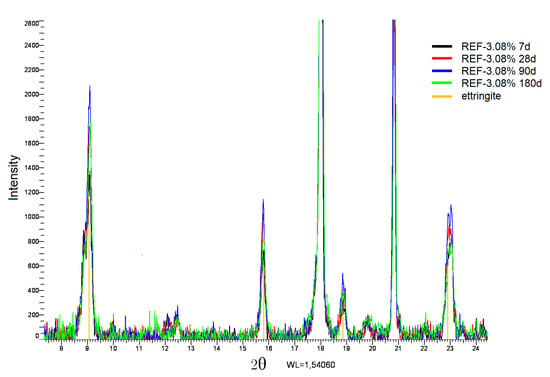
Figure 4.
XRD analysis of “REF-3.08%” at 7, 28, 90, and 180 days.
Figure 5 shows the flexural and compressive strength of the mortar samples after 7, 28, 90, and 180 days. As expected, the mortar with natural aggregates has a better mechanical performance than those with the reference FRA. The heavily contaminated sample REF-3.08% showed a higher flexural and compressive strength than REF-0.47%, even though it underwent significant swelling. The samples with the industrial FRA performed between the natural aggregates and the reference FRA, confirming their higher quality compared to a pure crushed concrete. This could again be due to the irregular shape of the REF aggregates: the higher air content in these mixes affected their mechanical resistance.
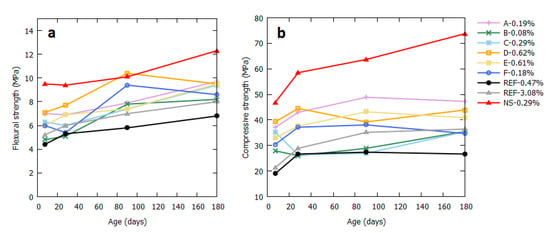
Figure 5.
Flexural (a) and compressive (b) strength of the mortar samples after 7, 28, 90, and 180 days.
4. Conclusions
Between the three different sampled recycling centers and even between different samples from the same center, a large variability was found in the FRA they offered. Results showed their water absorptions ranging from 6.1% to 14.6% and sulfate contents from 0.15% to 0.80%. Both of these characteristics increased with particle fineness, explaining how small particles sizes can be more difficult to incorporate than coarser grains.
Pure, uncontaminated, crushed concrete had a sulfate content of 0.18%, showing that sulfates are not only originating from gypsum but also residual cement particles. Regardless of their source, all water soluble sulfates can contribute to sulfate attack. Mortars made with this reference recycled material showed a lower compressive strength than those with industrial FRA. Lots of research done on the incorporation of FRA in mortars or concrete is done with reference recycled materials, so this could mean that the quality of industrial FRA is underestimated.
Swelling tests on mortars showed that no harmful swelling occurred when industrial FRA were incorporated. While internal sulfate attack caused by contaminated FRA is definitely a relevant deteriorating reaction, exaggerated sulfate amounts were necessary to provoke any swelling. The sulfate contents found in industrial FRA, while still largely surpassing the 0.2% limit posed in EN 206, did not pose this threat to the mechanical stability of the mortar.
For these reasons, FRA from recycling centers should be considered as a viable material to incorporate in mortars, provided that the mix design is adapted to account for their lower density and higher water absorption. Future work should focus on upscaling these tests to concrete, to further evaluate the established sulfate limit.
Based on these results, the sulfate limit of 0.2% posed in EN 206 could be reconsidered to be less strict. Mortars made with sulfate contents of up to 0.6% did not show any significant deteriorating reaction.
Supplementary Materials
The following are available online at https://www.mdpi.com/1996-1944/13/21/4866/s1, Figure S1: Swelling curve corresponding to Figure 3a, shown with error bars, Table S1: T-test results of the swelling curves. A red color means that samples differed significantly from each other for p < 0.05.
Author Contributions
Investigation, C.C.; writing—original draft preparation, C.C.; writing—review and editing, D.B., S.R., Z.Z., and L.C.; visualization, C.C.; supervision, D.B. and L.C.; project administration, D.B., S.R., Z.Z., and L.C. All authors have read and agreed to the published version of the manuscript.
Funding
This research was conducted in the framework of the Interreg project VALDEM “Solutions intégrées de valorisation des flux ‘matériaux’ issus de la démolition des bâtiments: approche transfrontalière vers une économie circulaire” (Convention n 1.1.57 of Interreg France–Wallonie-Vlaanderen 2014–2020).
Conflicts of Interest
The authors declare no conflict of interest. The funding source had no role in the design of the study; in the collection, analyses, or interpretation of data; in the writing of the manuscript; or in the decision to publish the results.
References
- United Nations Environment Programme. Sustainable Buildings and Climate Initiative; United Nations Environment Programme: Nairobi, Kenya, 2016. [Google Scholar]
- Coelho, A.; De Brito, J. Influence of construction and demolition waste management on the environmental impact of buildings. Waste Manag. 2012, 32, 532–541. [Google Scholar] [CrossRef] [PubMed]
- European Commission. On Resource Efficiency Opportunities in the Building Sector. COM/2014/0445fina. 2014. Available online: https://ec.europa.eu/environment/eussd/pdf/SustainableBuildingsCommunication.pdf (accessed on 6 August 2020).
- Behera, M.; Bhattacharyya, S.; Minocha, A.; Deoliya, R.; Maiti, S. Recycled aggregate from C&D waste and its use in concrete: A breakthrough towards sustainability in construction sector: A review. Constr. Build. Mater. 2014, 68, 501–516. [Google Scholar] [CrossRef]
- Deloitte. Study on Resource Efficient Use of Mixed Wastes, Improving Management of Construction and Demolition Waste: Final Report; Prepared for the European Commission; Deloitte: London, UK, 2017. [Google Scholar]
- Council Directive 2008/98/EC of the European Parliament. On Waste and Repealing Certain Directives. Official Journal of the European Union L312. 2008. Available online: http://data.europa.eu/eli/dir/2008/98/2018-07-05 (accessed on 6 September 2020).
- European Aggregates Association. Annual Review. 2017. Available online: https://uepg.eu/mediatheque/media/AR_2017-2018.pdf (accessed on 6 September 2020).
- Thormark, C. Conservation of energy and natural resources by recycling building waste. Resour. Conserv. Recycl. 2001, 33, 113–130. [Google Scholar] [CrossRef]
- Wilburn, D.; Goonan, T. Aggregates from Natural and Recycled Sources: Economic Assessments for Construction Applications, a Materials Flow Analysis; Technical Report; U.S. Department of the Interior: Washington, DC, USA, 1998.
- Delvoie, S.; Zhao, Z.; Michel, F.; Courard, L. Market analysis of recycled sands and aggregates in NorthWest Europe: Drivers and barriers. In Proceedings of the IOP Conference series: Earth and Environmental Science, Brussels, Belgium, 5–7 February 2019; pp. 1–8. [Google Scholar] [CrossRef]
- Oikonomou, N. Recycled concrete aggregates. Cem. Concr. Compos. 2005, 27, 315–318. [Google Scholar] [CrossRef]
- Bravo, M.; De Brito, J.; Pontes, J.; Evangelista, L. Mechanical performance of concrete made with aggregates from construction and demolition waste recycling plants. J. Clean. Prod. 2015, 99, 59–74. [Google Scholar] [CrossRef]
- Gutierrez, P.; Sanchez de Juan, M. Utilization of Recycled Concrete Aggregate for Structural Concrete; Service Life Design for Infrastructures: Delft, The Netherlands, 2018. [Google Scholar]
- Rao, A.; Jha, K.; Misra, S. Use of aggregates from recycled construction and demolition waste in concrete. Resour. Conserv. Recycl. 2007, 50, 71–81. [Google Scholar] [CrossRef]
- Zhao, Z.; Courard, L.; Groslambert, S.; Jehin, T.; Léonard, A.; Xiao, J. Use of recycled concrete aggregates from precast block for the production of new building blocks: An industrial scale study. Resour. Conserv. Recycl. 2020, 157, 104786. [Google Scholar] [CrossRef]
- Evangelista, L.; De Brito, J. Concrete with fine recycled aggregates: A review. Eur. J. Environ. Civ. Eng. 2014, 18, 129–172. [Google Scholar] [CrossRef]
- Khatib, J. Properties of concrete incorporating fine recycled aggregate. Cem. Concr. Res. 2005, 35, 763–769. [Google Scholar] [CrossRef]
- Zhao, Z.; Rémond, S.; Damidot, D.; Xu, W. Influence of hardened cement paste content on the water absorption of fine recycled concrete aggregates. J. Sustain. Cem. Based Mater. 2013, 2, 186–203. [Google Scholar] [CrossRef]
- Tam, V.; Tam, C.; Le, K. Removal of cement mortar remains from recycled aggregate using pre-soaking approaches. Resour. Conserv. Recycl. 2007, 50, 82–101. [Google Scholar] [CrossRef]
- Bravo, M.; de Brito, J.; Pontes, J.; Evangelista, L. Durability performance of concrete with recycled aggregates from construction and demolition waste plants. Constr. Build. Mater. 2015, 77, 357–369. [Google Scholar] [CrossRef]
- Braymand, S.; Roux, S.; Deodonne, K.; Mihalcea, C.; Feugeas, F.; Fond, C. Les Granulats RecycléS de BéTons: Un MatéRiau à Fort Potentiel de Valorisation Dans Les BéTons; Matériaux: Montpellier, France, 2014. [Google Scholar]
- Collepardi, M. A state of the art review on delayed ettringite attack on concrete. Cem. Concr. Compos. 2003, 25, 401–407. [Google Scholar] [CrossRef]
- Asakura, H.; Watanabe, Y.; Ono, Y.; Yamada, M.; Inoue, Y.; Alfaro, A.M. Characteristics of fine processed construction and demolition waste in Japan and method to obtain fines having low gypsum component and wood contents. Waste Manag. Res. 2010, 28, 634–646. [Google Scholar] [CrossRef] [PubMed]
- Ambrós, W.; Sampaio, C.; Cazacliu, B.; Miltzarek, G.; Miranda, L.R. Separation in air jigs of mixed construction and demolition waste. In Advances in Recycling and Management of Construction and Demolition Waste; Delft University of Technology: Delft, The Netherlands, 2017; pp. 25–28. [Google Scholar]
- Agrela, F.; de Juan, M.S.; Ayuso, J.; Geraldes, V.; Jiménez, J. Limiting properties in the characterisation of mixed recycled aggregates for use in the manufacture of concrete. Constr. Build. Mater. 2011, 25, 3950–3955. [Google Scholar] [CrossRef]
- Diamond, S. Delayed Ettringite Formation: Processes and Problems. Cem. Concr. Compos. 1996, 18, 205–215. [Google Scholar] [CrossRef]
- Breysse, D. Deterioration processes in reinforced concrete: An overview. In Non-Destructive Evaluation of Reinforced Concrete Structures: Deterioration Processes and Standard Test Methods; Maierhofer, C., Reinhardt, H., Dobmann, G., Eds.; Woodhead Publishing: Sawston, UK, 2010. [Google Scholar]
- Taylor, H.; Famy, C.; Scrivener, K. Delayed ettringite formation. Cem. Concr. Res. 2001, 31, 683–693. [Google Scholar] [CrossRef]
- European Committee for Standardization. EN 206 ‘Concrete: Specification, Performance, Production and Conformity: Annex E.3 on Recycled Aggregates’; European Committee for Standardization: Brussels, Belgium, 2014. [Google Scholar]
- Yammine, A.; Nordine, L.; Choinska, M.; Bignonnet, F.; Mechling, J. DEF damage in heat cured mortars made of recycled concrete sand aggregate. Constr. Build. Mater. 2020, 252. [Google Scholar] [CrossRef]
- Rougeau, P.; Schmitt, L.; Nai-Nhu, J.; Djerbi, A.; Saillio, M.; Ghorbel, E.; Mechling, J.M.; Lecomte, A.; Trauchessec, R.; Bulteel, D.; et al. Durability-related properties. In Concrete Recycling : Research and Practice; De Larrard, F., Colina, H., Eds.; CRC Press: Boca Raton, FL, USA, 2019. [Google Scholar]
- European Committee for Standardization. EN 933 ’Tests for Geometrical Properties of Aggregates. Part 1: Determination of Particle Size Distribution’; European Committee for Standardization: Brussels, Belgium, 2012. [Google Scholar]
- European Committee for Standardization. EN 1744-1 ‘Tests for Chemical Properties of Aggregates. Part 1: Chemical Analysis’; European Committee for Standardization: Brussels, Belgium, 2014. [Google Scholar]
- Bock, E. On the solubility of anhydrous calcium sulphate and of gypsum in concentrated solutions of sodium chloride at 25 ∘C, 30 ∘C, 40 ∘C and 50 ∘C. Can. J. Chem. 1961, 39, 1746–1751. [Google Scholar] [CrossRef]
- Colman, C.; Zhao, Z.; Michel, F.; Rémond, S.; Bulteel, D.; Courard, L. Gypsum Residues in Recycled Materials: Characterization of Fine Recycled Aggregates; Service Life Design for Infrastructures: Delft, The Netherlands, 2018. [Google Scholar]
- European Committee for Standardization. EN 1097-6 ‘Tests for Mechanical and Physical Properties of Aggregates. Part 6: Determination of Particle Density and Water Absorption’; European Committee for Standardization: Brussels, Belgium, 2001. [Google Scholar]
- IFSTTAR. Test Method No. 78:2011. Tests on Aggregates for Concrete: Measurement of Total Water Absorption by a Crushed Sand; IFSTTAR: Paris, France, 2011.
- Le, T.; Remond, S.; Le Saout, G.; Garcia-Diaz, E. Fresh behavior of mortar based on recycled sand: Influence of moisture condition. Constr. Build. Mater. 2016, 106, 35–42. [Google Scholar] [CrossRef]
- Delobel, F.; Bulteel, D.; Mechling, J.; Lecomte, A.; Cyr, M.; Rémond, S. Application of ASR tests to recycled concrete aggregates: Influence of water absorption. Constr. Build. Mater. 2016, 124, 714–721. [Google Scholar] [CrossRef]
- European Committee for Standardization. EN 196-1 ’Methods of Testing Cement. Part 1: Determination of Strength’; European Committee for Standardization: Brussels, Belgium, 2014. [Google Scholar]
- Colman, C.; Zhao, Z.; Michel, F.; Rémond, S.; Bulteel, D.; Courard, L. Internal Sulfate Attack Caused by Gypsum Contamination of Recycled Aggregates: Development of a Swelling Test Protocol; Journées Scientifiques RF2B: Anglet, France, 2018. [Google Scholar]
- Hansen, T.; Narud, H. Strength of recycled concrete made from crushed concrete coarse aggregate. Concr. Int. 1983, 5, 79–83. [Google Scholar]
- Nassar, R.; Soroushian, P. Strength and durability of recycled aggregate concrete containing milled glass as partial replacement for cement. Constr. Build. Mater. 2012, 29, 368–377. [Google Scholar] [CrossRef]
- Poon, C.; Shui, Z.; Lam, L. Effect of microstructure of ITZ on compressive strength of concrete prepared with recycled aggregates. Constr. Build. Mater. 2004, 18, 461–468. [Google Scholar] [CrossRef]
- Pavoine, A.; Brunetaud, X.; Divet, L. The impact of cement parameters on Delayed Ettringite Formation. Cem. Concr. Compos. 2012, 34, 521–528. [Google Scholar] [CrossRef]
- Aubert, J.; Escadeillas, G.; Leklou, N. Expansion of five-year-old mortars attributable to DEF. Constr. Build. Mater. 2009, 23, 3583–3585. [Google Scholar] [CrossRef][Green Version]
- Batic, O.; Milanesi, C.; Maiza, P.; Marfil, S. Secondary ettringite formation in concrete subjected to different curing conditions. Cem. Concr. Res. 2000, 30, 1407–1412. [Google Scholar] [CrossRef]
- Mehdipour, I.; Khayat, K. Understanding the role of particle packing characteristics in rheophysical properties of cementitious suspensions: A literature review. Constr. Build. Mater. 2018, 161, 340–353. [Google Scholar] [CrossRef]
- Colman, C.; Bulteel, D.; Thiery, V.; Rémond, S.; Michel, F.; Courard, L. Internal sulfate attack in mortars containing contaminated fine recycled concrete aggregates. Constr. Build. Mater. Unpublished.
- Matias, D.; De Brito, J.; Rosa, A.; Pedro, D. Mechanical properties of concrete produced with recycled coarse aggregates: Influence of the use of superplasticizers. Constr. Build. Mater. 2013, 44, 101–109. [Google Scholar] [CrossRef]
Publisher’s Note: MDPI stays neutral with regard to jurisdictional claims in published maps and institutional affiliations. |
© 2020 by the authors. Licensee MDPI, Basel, Switzerland. This article is an open access article distributed under the terms and conditions of the Creative Commons Attribution (CC BY) license (http://creativecommons.org/licenses/by/4.0/).
